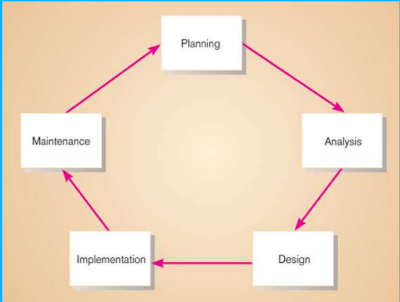Developing Information
Systems and System Development Life Cycle (SDLC)
Most
organizations use a standard set of steps, called a systems development methodology
to develop and support their information systems. It is a standard process followed
in an organization to conduct all the steps necessary to analyze, design, implement,
and maintain information systems. And systems development life cycle (SDLC) is
the traditional methodology used to develop, maintain, and replace information
systems. It includes different phases as shown in the figure below. This representation
of SDLC is sometimes referred to as the waterfall model or classic life cycle.
 |
| Fig: The systems development life cycle |
The
first phase is called planning. In this phase, someone identifies the need for
a new or enhanced system. These needs are then analyzed, prioritized, and
arranged into a plan for the IS department. Here, a potential information
systems project is explained and an argument for continuing or not continuing
with the project is presented; a detailed plan is also developed for conducting
the remaining phases of the SDLC for the proposed system.
The
next phase is called analysis. During this phase, the analyst studies the
current system and proposes alternative replacement systems. Here, the analyst
thoroughly studies the organization’s current procedures and the information
systems used to perform organizational tasks. The analyst work with users to
determine what the users want from a proposed system. The analyst carefully
studies any current systems, manual and computerized, that might be replaced or
enhanced as part of this project. The analyst studies the requirements and
structures them according to their interrelationships and eliminates any
redundancies; generates alternative initial designs to match the requirements;
compares these alternatives to determine which best meets the requirements within
the cost, labor, and technical levels the organization is willing to commit to
the development process. The output of this phase is a description of the
recommended alternative solution. Once the recommendation is accepted by
owners, you can begin to make plans to acquire any hardware and system software
necessary to build or operate the system as proposed.
The
next phase is called design. During this phase, you convert the description of
the recommended alternative solution into logical and then physical system
specification. Here, you must design all aspects of the system from input and
output screens to reports, databases, and computer processes. Logical design is
the part of the design process that is independent of any specific hardware or
software platform. Theoretically, the system could be implemented on any
hardware and systems software. Physical design is the part of the design phase
in which the logical specifications of the system from logical design are
transformed into technology-specific details from which all programming and
system construction can be accomplished.
The
next phase is called implementation. In this phase, the information system is coded,
tested, installed, and supported in the organization. During coding,
programmers write the programs that make up the information system. During
testing, programmers and analysts test individual programs and the entire
system in order to find and correct errors. During installation, the new system
becomes a part of the daily activities of the organization. Implementation
activities also include initial user support such as the finalization of
documentation, training programs, and ongoing user assistance.
The
final phase of SDLC is called maintenance. In this phase, the information system is
systematically repaired and improved. When a system is operating in an
organization, users sometimes find problems with how it works and often think
of better ways to perform its functions. Also the organization’s needs with
respect to the system change over time. In maintenance, you make the changes
that users ask for and modify the system to reflect changing business
conditions. The waterfall model is the oldest and the most widely used paradigm for
information systems development. While it does have weaknesses, it is
significantly better than a haphazard approach. This model is suitable for projects in which user requirements are certain and precise. The problems that
are sometimes encountered with the linear sequential model are:
- Changes can cause
confusion as to the project team's proceeds.
- It is often difficult for
the customer to state all requirements explicitly. The linear sequential model
requires this and makes difficult to respond to changing customer
requirements.
- A working version of the
system will be available to customers late in the project time span. A major
blunder, if undetected until the working program is reviewed, can be
disastrous.
- The linear nature of the
classic life cycle leads to “blocking states” in which some project team
members must wait for other members of the team to complete dependent tasks.
- User involvement is
limited.



Comments
Post a Comment
Subscribe Us and Thanks for visiting blog.